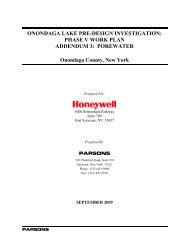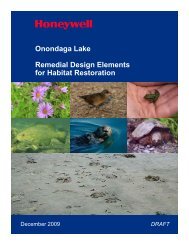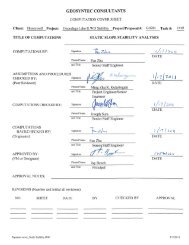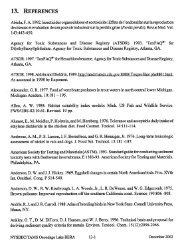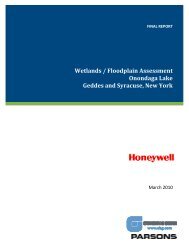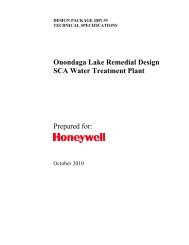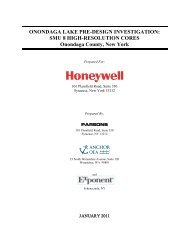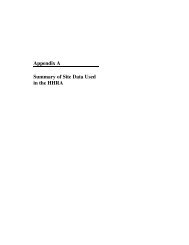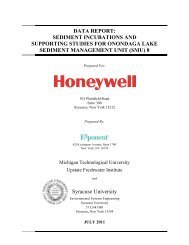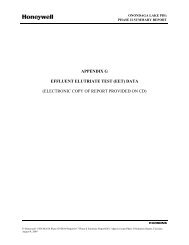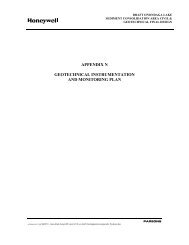Phase 1B Underwater Archaeological Report for the Onondaga ...
Phase 1B Underwater Archaeological Report for the Onondaga ...
Phase 1B Underwater Archaeological Report for the Onondaga ...
You also want an ePaper? Increase the reach of your titles
YUMPU automatically turns print PDFs into web optimized ePapers that Google loves.
FINAL<br />
<strong>Phase</strong> IB <strong>Underwater</strong> <strong>Archaeological</strong> Resources <strong>Report</strong> <strong>for</strong> <strong>Onondaga</strong> Lake Superfund Site<br />
Anomaly 35: Unidentified Watercraft<br />
Anomaly 35 Summary Table<br />
Anomaly Identification Unidentified Watercraft; NY Site Number 06740.012302<br />
Remedial Impact<br />
Dredge and Cap<br />
NRHP Eligibility<br />
Eligible as Contributing Property to Syracuse Maritime Historic District<br />
Recommendation<br />
Anomaly Dataset<br />
Side Scan (2005)<br />
No<br />
Magnetometer (2005) 604, 632, 617, 256, 645, 660<br />
Side Scan (2010) 6/3/10<br />
Sector Scan (2010) 6/7/10<br />
ROV Video Footage (2010) 6/10/10<br />
Diver Observations Yes<br />
Diver Videography<br />
No<br />
Maps/Charts<br />
No<br />
Aerial Imagery<br />
No<br />
Historic Accounts<br />
No<br />
Research Results<br />
Anomaly A35 represents <strong>the</strong> remains of a watercraft that could not be conclusively identified due to its<br />
buried condition (Figure 58). The site was examined in June 2010 with sector scan and side scan sonar<br />
which yielded no returns suggesting <strong>the</strong> presence of a submerged cultural resource. The underwater<br />
videography recorded by <strong>the</strong> ROV showed a scatter of timbers which LCMM staff were unable to<br />
conclusively identify. Due to <strong>the</strong> lack of sufficient data to assess <strong>the</strong> nature and potential significance of<br />
<strong>the</strong> site, <strong>the</strong> anomaly was investigated by archaeological divers in October 2010. This inspection<br />
revealed <strong>the</strong> site to be <strong>the</strong> largely buried remains of a watercraft of unknown origin.<br />
The site lies in approximately 4 feet (1.22m) of water, with an extant length and beam of 64 feet<br />
(19.51m) and approximately 14½ feet (4.42m), respectively. Very little of <strong>the</strong> site is exposed; however,<br />
<strong>the</strong> visible remains suggest that <strong>the</strong> bottom 2 to 4 feet (.61 - 1.22m) of <strong>the</strong> vessel is preserved under <strong>the</strong><br />
lake bottom. The principal visible features include stern framing and planking, deadwood, keelson,<br />
sternpost, and a wooden hogging truss. The vessel’s stern is <strong>the</strong> most exposed portion of <strong>the</strong> remains<br />
consisting of a sternpost, frames, planking and deadwood. An iron rub rail was noted on <strong>the</strong> exterior of<br />
<strong>the</strong> port side at <strong>the</strong> stern. The planking goes from outboard of <strong>the</strong> frames to on top (interior) of <strong>the</strong><br />
sternpost, which suggests that <strong>the</strong> sternpost is preserved to its original height. The stern post is vertical<br />
with an iron plate on <strong>the</strong> side and a gudgeon <strong>for</strong> securing <strong>the</strong> rudder. The sternpost is rein<strong>for</strong>ced on its<br />
interior side with deadwood. The port side of <strong>the</strong> stern has five frames while <strong>the</strong> starboard side does<br />
not have any. The framing is light with moulded and sided dimensions of 3 inches (7.62cm). The <strong>for</strong>m of<br />
<strong>the</strong> stern was difficult to determine given <strong>the</strong> paucity of exposed timbers, however, <strong>the</strong> shape is<br />
believed to be scow-like. The boat amidships had two 10 foot (3m) long longitudinal beams which were<br />
angled downward toward <strong>the</strong> stern with <strong>the</strong> bow end about 1 foot (.3m) above <strong>the</strong> lake bottom. These<br />
beams are believed to be <strong>the</strong> remains of a wooden hogging truss. The exposed remains at <strong>the</strong> bow<br />
consist of a 20 foot (6.1m) run of <strong>the</strong> keelson and <strong>the</strong> top of one frame. Probing in <strong>the</strong> bow showed <strong>the</strong><br />
remains to be buried below only 6 to 12 inches (15 to 30cm) of sediment. The maximum length of <strong>the</strong><br />
remains was 64 feet (19.51m); however, <strong>the</strong> stem was not located thus <strong>the</strong> true length of <strong>the</strong> boat is<br />
unknown. There is a large coil of wire rope amidships.<br />
The paucity of exposed remains do not allow <strong>for</strong> a conclusive identification of <strong>the</strong> vessel type. The two<br />
candidate boat types are a small steamer (with machinery removed) or a canal boat. The beam<br />
79



